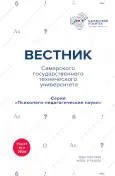Особенности развития прагматической компетенции в процессе обучения иностранному языку студентов университета
- Авторы: Пирогова Н.Г.1, Рожков Г.А.1
-
Учреждения:
- Санкт-Петербургский государственный химико-фармацевтический университет
- Выпуск: Том 21, № 2 (2024)
- Страницы: 49-64
- Раздел: Теория и методология образования
- URL: https://journals.rcsi.science/1991-8569/article/view/260674
- DOI: https://doi.org/10.17673/vsgtu-pps.2024.2.4
- ID: 260674
Цитировать
Полный текст
Аннотация
Основная задача проведенного исследования – разработка методики формирования прагматической компетенции у студентов Санкт-Петербургского государственного химико-фармацевтического университета (СПХФУ) при обучении английскому языку. Для того чтобы свободно использовать язык, обучающимся необходимо изучать не только языковые формы и значения. Практический опыт преподавания показывает, что одной из основных задач обучения иностранному языку является развитие прагматической компетенции, при этом не во многих учебниках по английскому языку данный аспект находит свое отражение. Основной фокус исследования – формирование и развитие прагматической компетенции, которая включает как лингвистические, так и культурные знания. Представлены способы совершенствования прагматической компетенции. Результаты исследования, которое носит экспериментальный формат, показали, что целенаправленная работа над прагматическими аспектами на занятиях по английскому языку способствует развитию прагматической компетенции у студентов.
Ключевые слова
Полный текст
Открыть статью на сайте журналаОб авторах
Надежда Геннадьевна Пирогова
Санкт-Петербургский государственный химико-фармацевтический университет
Автор, ответственный за переписку.
Email: pirogova.nadezhda@pharminnotech.com
кандидат педагогических наук, доцент, Научно-образовательный центр иностранных языков и межкультурной коммуникации
Россия, 197376, г. Санкт-Петербург, ул. проф. Попова, 14Григорий Александрович Рожков
Санкт-Петербургский государственный химико-фармацевтический университет
Email: grigory.rozhkov@pharminnotech.com
кандидат педагогических наук, доцент, директор Научно-образовательного центра иностранных языков и межкультурной коммуникации
Россия, 197376, г. Санкт-Петербург, ул. проф. Попова, 14Список литературы
- Crystal D. A Dictionary of Linguistics and Phonetics. Oxford: Blackwell, 1985. 277 p.
- Bardovi-Harlig K., Mahan-Taylor R. Introduction to teaching pragmatics. English Teaching Forum. 2002. Vol. 41. No. 3. Pp. 37–39.
- Canale M., Swain M. Theoretical bases of communicative approaches to second language teaching an testing. Applied Linguistics. 1980. Vol. 1. No. 1. Pp. 11–47.
- Canale M. From Communicative Competence to Communicative Language Pedagogy. Language and Communication. London: Longman, 1983. 26 p.
- Kasper G., Rose K. Pragmatic development in a Second language. Oxford, Malden: Blackwell Publishing, 2002. 364 p.
- Ishihara N., Cohen A. Teaching and learning pragmatics. Where language and culture meet. Great Britain: Longman Applied Linguistics, 2010. 384 p.
- Felix-Brasdefer J.C., Cohen A.D. Teaching pragmatics in the foreign language classroom: Grammar as a communicative resource. Hispania. 2012. Vol. 95. No. 4. Pp. 650–669.
- Thomas J. Cross-cultural pragmatic failure. Applied Linguistics. 1983. Vol. 4. Pp. 91–112.
- Savignon S.J. Communicative Competence: Theory and Classroom Practice. Reading. MA: Addison-Wesley Publishing Company, 1983. 322 p.
- Edwards M., Csizer K. Developing pragmatic competence in the EFL classroom. English Teaching Forum. 2004. Vol. 42. No. 3. Pp. 35–41.
- Martinez-Flor A., Uso-Juan E. A comprehensive pedagogical framework to develop pragmatics in the foreign language classroom. The 6Rs approach. Applied Language Learning. 2006. Vol. 16. Pp. 39–64.
- Lyons J. Language and Linguistics. Cambridge: CUP, 1990. 356 p.
- Crozet C. A conceptual framework to help teachers identify where culture is located in language use. Teaching invisible culture: Classroom practice and theory. Melbourne: Language Australia, 2003. Pp. 34–39.
- McKay S. Western culture and the teaching of English as an international language. English Teaching Forum Online. 2004. Vol. 42. No.2. Pp. 10–15.
- Kilickaya F. Authentic materials and cultural content in EFL classrooms. The Internet TESL Journal. 2004. Vol. 1. No. 7. Pp. 1–5.
- Sykes J. Learner request in Spanish: Examining the potential of multi-user environments: User-driven design and implementation for language learning. Teaching through multi-user virtual environments: Applying dynamic elements to the modern classroom. Hershey, PA: iGI Global, 2009. Pp. 238–305.
- Dewey J. Experience and Education. New York: Macmillan, 1938. 116 p.
- Hymes D.H. On Communicative Competence. Sociolinguistics: Selected Readings. Penguin, 1985. Pp. 269–293.
- Saito H., Beecken M. An approach to instruction of pragmatic aspects: Implications of pragmatic transfer by American learners of Japanese. The Modern Language Journal. 1997. Vol. 81. No. 3. Pp. 363–377.
- Barron A. Acquisition in Interlanguage Pragmatics. Learning how to do things with words in a study abroad context. Philadelphia: John Benjamins Publishing Company, 2003. 403 p.
- Kim D., Hall J. The role of an interactive book reading program in the development of second language pragmatic competence. The Modern Language Journal. 2002. Vol. 86. No. 3. Pp. 332–348.
- Huth T., Nikazm C. How can insights from conversation analysis be directly applied to teaching L2 pragmatics? Language Teaching Research. 2006. Vol. 10. No. 1. Pp. 53–79.
- Mey L.J. Pragmatics: An Introduction. Oxford: Blackwell Publishers, 1993. 357 p.
- Krulatz A., Dixon T. Fostering Pragmatic Competence: Focus on Refusals. Tri-TESOL 2015 – Transcending Boundaries and Interweaving Perspectives: Conference Proceedings. 2016. Pp. 47–58.
Дополнительные файлы







